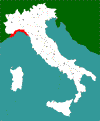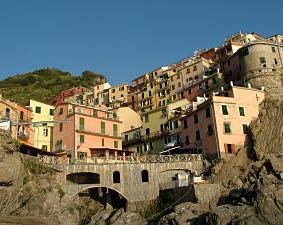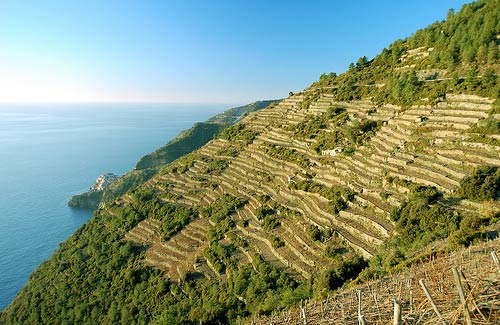Liguria
NORTH WEST ITALY
Primary grape varieties:
White Grapes:Albarola, Pigato, Vermentino, Bosco
Red Grapes:Dolcetto (Ormeasco), Rossese, Sangiovese, Cabernet
 Crescent shaped Liguria borders France to the west, Piedmont to the north, and Emilia-Romagna and Tuscany to the east. It is the third smallest wine region of Italy and one of the prettiest. Its Riviera playgroundand its beautiful flora are known the world over.
Crescent shaped Liguria borders France to the west, Piedmont to the north, and Emilia-Romagna and Tuscany to the east. It is the third smallest wine region of Italy and one of the prettiest. Its Riviera playgroundand its beautiful flora are known the world over.The region is dominated by the Maritime Alps and the Ligurian Apennines that form a natural barrier against the winter winds. These mountains descend virtually all the way to the sea, isolating Ligurua from its neighbors until the 'autostrada' improved access to the hillside villages thereby opening the region to wine markets in the other parts of Italy and France. Liguria is divided into four provinces: Genoa (Genova), Imperia, La Spezia and Savona. Genoa, with its great port, is the capital.
 While not a large wine-producer, Liguria nonetheless makes white wines of some quality that complement the local cuisine. Indeed, the region's gastronomy is as noteworthy as its wines, uniting gifts from the sea with the produce of steep hillsides, particularly basil and garlic for pesto. Breads and polenta made from dry chickpeas and chestnuts as well as lasagna made from chestnut flour appear on Ligurian menus even today. Bread is most often in the form of rolls or focaccia with oil, onion or cheese. The favoured pizza is made with onion, garlic, tomatoes, black olives and anchovies or sardines. Sea bass, prawns, scallops, oysters and lobster abound as do recipes for sardines and anchovies (local wine's generally enhance seafood dishes), while veal, rabbit, poultry and lamb are the preferred meats. Liguria's few cheeses include parmigiano reggiano, pecorino and fresh ricotta.
While not a large wine-producer, Liguria nonetheless makes white wines of some quality that complement the local cuisine. Indeed, the region's gastronomy is as noteworthy as its wines, uniting gifts from the sea with the produce of steep hillsides, particularly basil and garlic for pesto. Breads and polenta made from dry chickpeas and chestnuts as well as lasagna made from chestnut flour appear on Ligurian menus even today. Bread is most often in the form of rolls or focaccia with oil, onion or cheese. The favoured pizza is made with onion, garlic, tomatoes, black olives and anchovies or sardines. Sea bass, prawns, scallops, oysters and lobster abound as do recipes for sardines and anchovies (local wine's generally enhance seafood dishes), while veal, rabbit, poultry and lamb are the preferred meats. Liguria's few cheeses include parmigiano reggiano, pecorino and fresh ricotta.Perhaps owing to a keen appreciation of the limited nature of their wines, the Ligurian's are a people of moderation, consuming less wine than their neighbors. Winemaking itself is less prevalent than it was in the past, a situation that is probably attributable to the miniscule size of individual vineyards and the extraordinarily difficult terrain (farmers worry not so much about drought or flood but concentrate instead on not falling off the cliffs. Many now find more profit in tourism, olives and flower growing).
Despite low production volumes, approximately 85 wine styles are produced from over 100 varietals, both indigenous and localized. Viticulture is concentrated in an area between Genoa and La Spezia, known as Le Cinque Terre (Five Lands). The rugged terrain of this narrow coastal stretch means that vineyards are scattered and limited, but the wine they produce can be well worth seeking out. The legendary name among these has been produced for centuries: 'Cinqueterre', a famous white wine, is straw coloured, with a delicate bouquet and a dry, though relatively neutral flavour. It is today made from Bosco plus Albarola and / or Vermentino grapes from vineyards surrounding five fishing villages, which until recently could only be reached by sea. These same villages are now connected by paths that present a challenge to tourists at least equal to that of the farmers at harvest: Vines are planted on vertigo-inducing, hard to reach terraces, close enough to the sea that they bask in the mist as waves break against the shore.

Above: The Cinque Terre Vineyards
Much rarer than 'Cinqueterre' is 'Cinque Terre Sciacchetra', a sweet version, made with partly dried grapes and with a higher alcoholic content. Its sweetness can vary and, accordingly, Sciacchetra can be served either chilled as an aperitif or as a dessert wine.
Other whites of mention are Pigato del Albenga and Vermentino that come under the DOC Riviera Ligure di Ponente; the former, a high acid variety, produces an extremely floral and fragrant white with hints of fennel. Rossese di Dolceacqua, produced near the French border, is a ruby red wine with a delicate strawberry aroma; warm and soft, it is similar in style to Beaujolais. Made from the Rossese grape, the wine has been famous since a visit by Napoleon in 1805. Most other wines of Liguria are curiosities, local whites and reds that are usually at their best consumed young and close to home. Such rarities as Buzzeto and Granaccia, Coronata and Lumassina are uniquely and proudly Ligurian.
